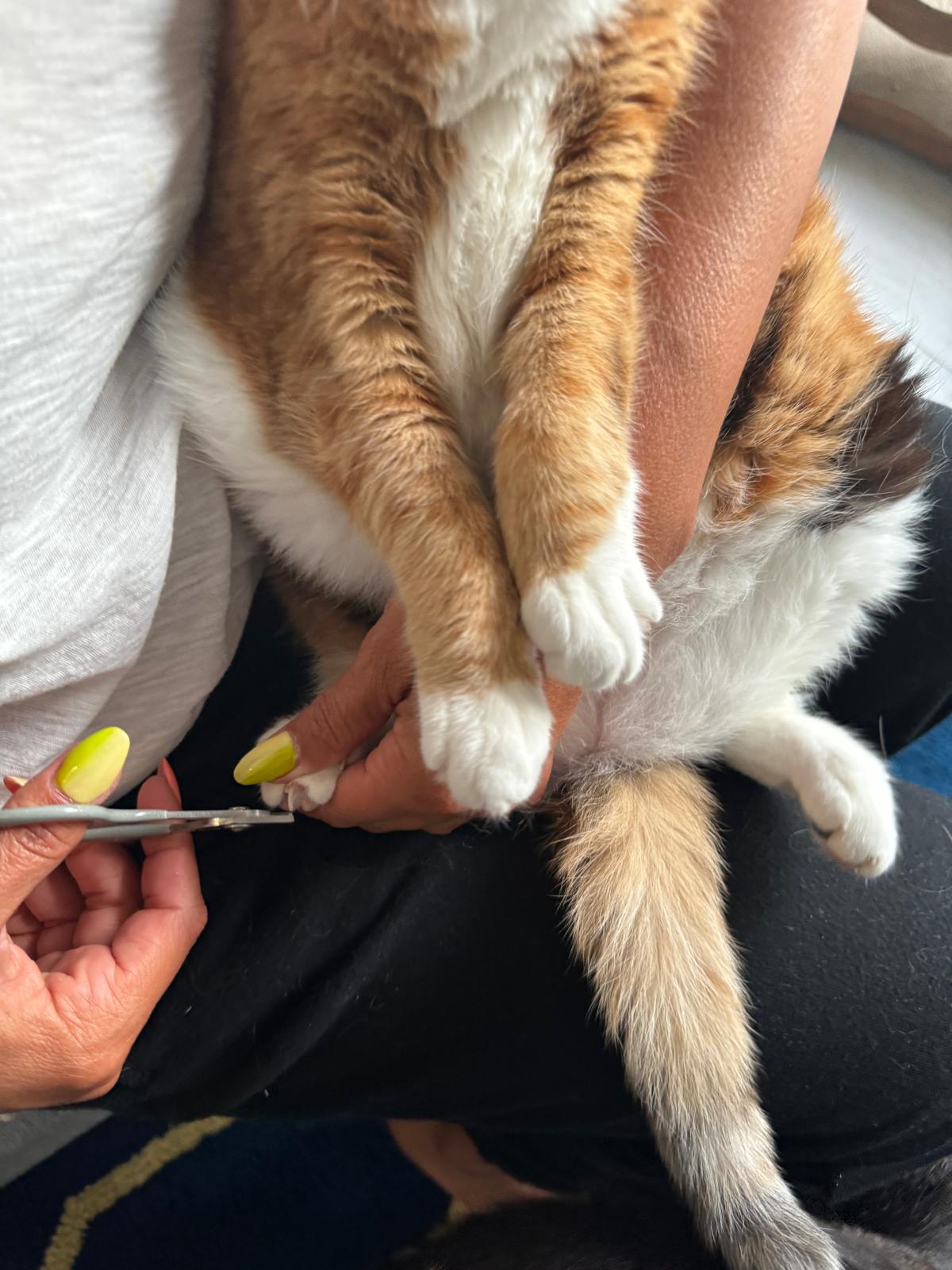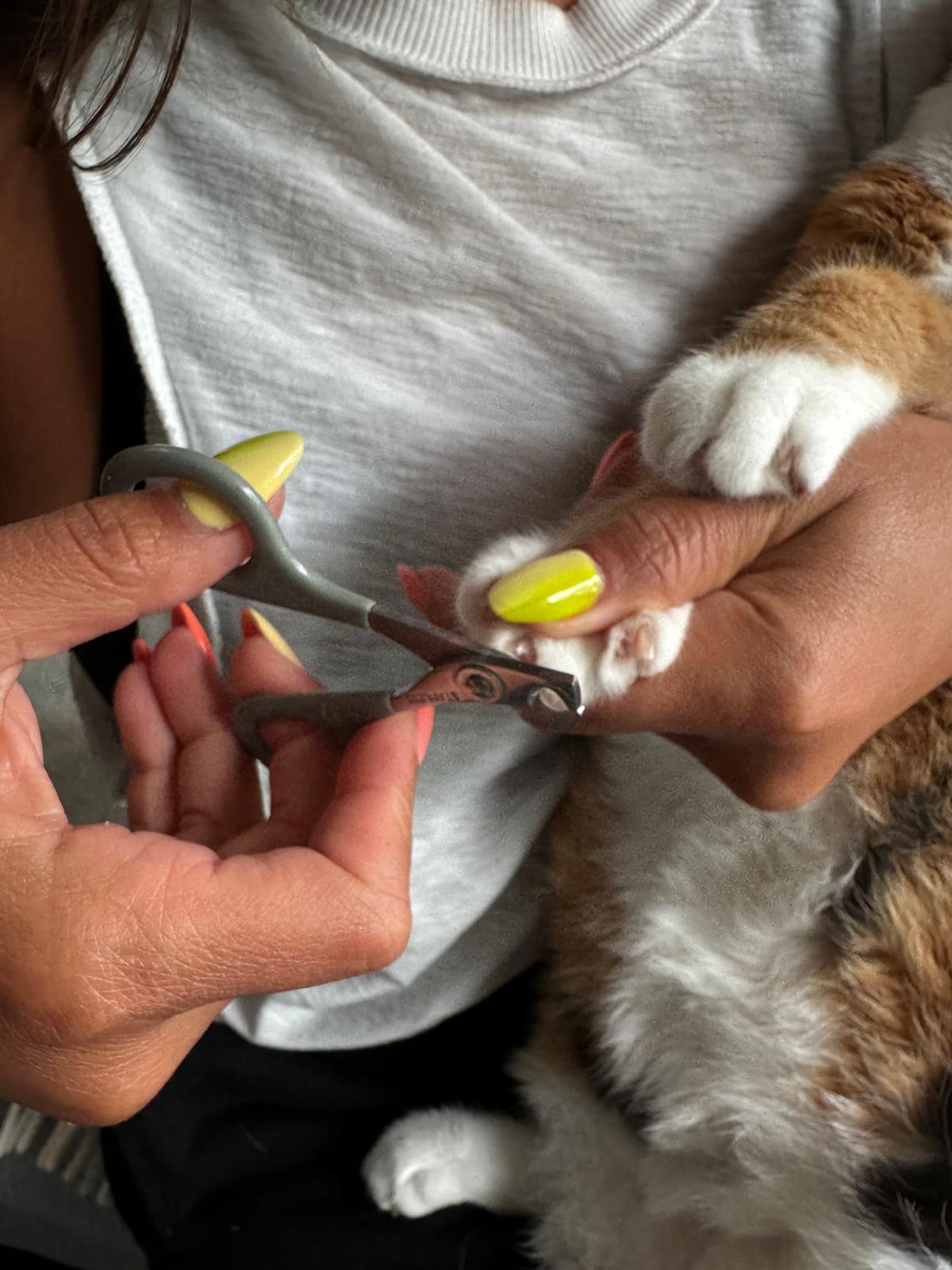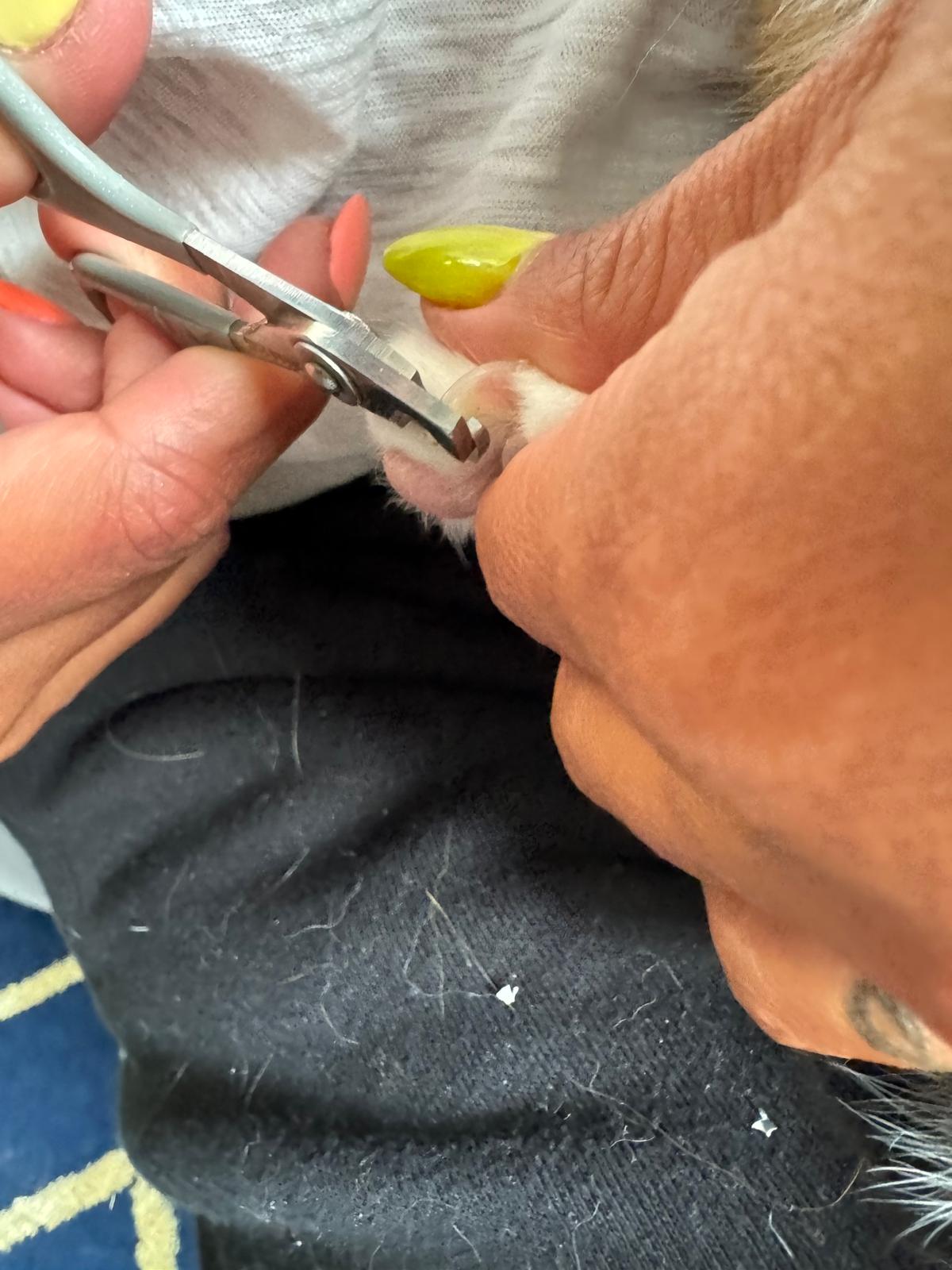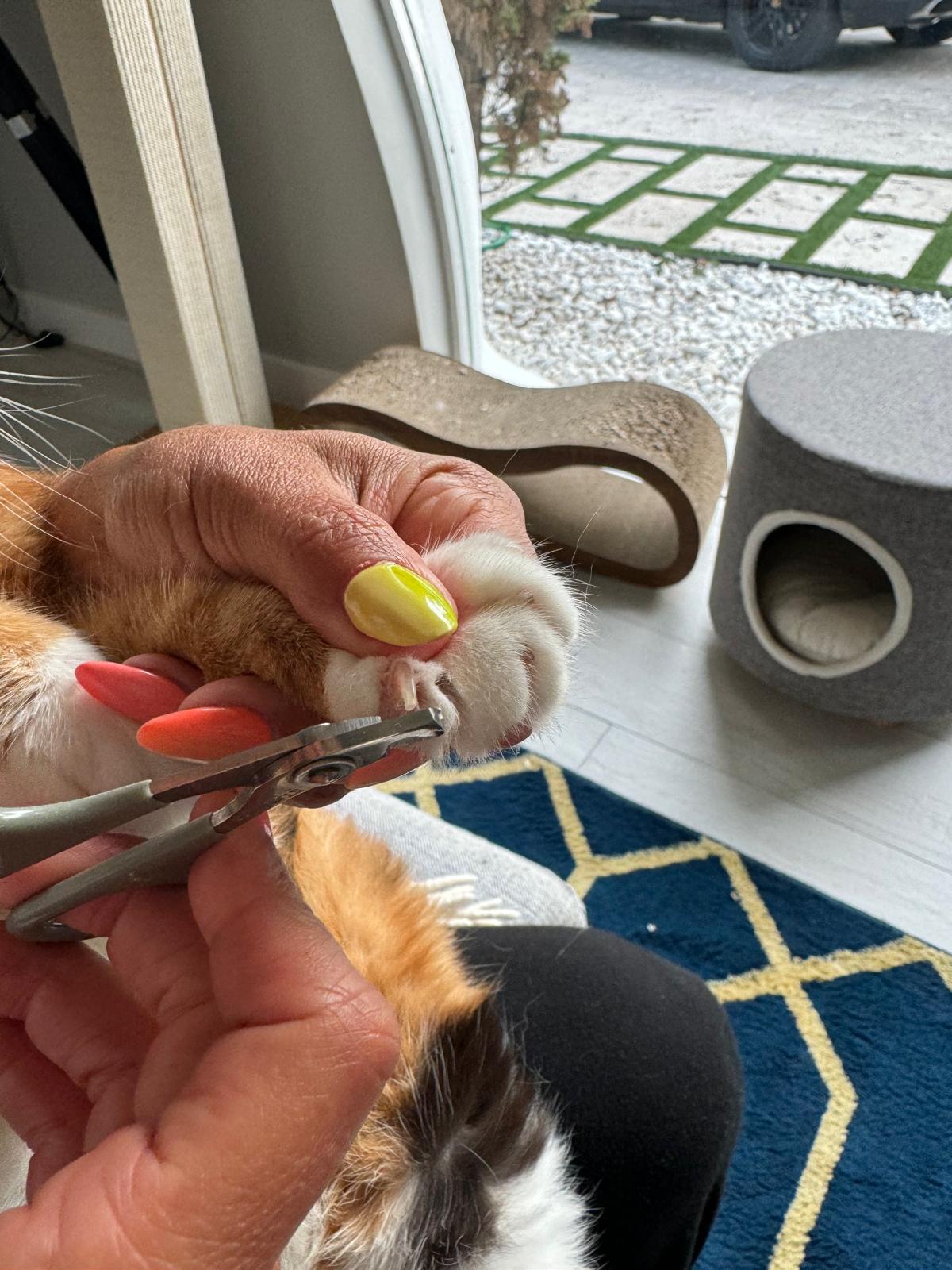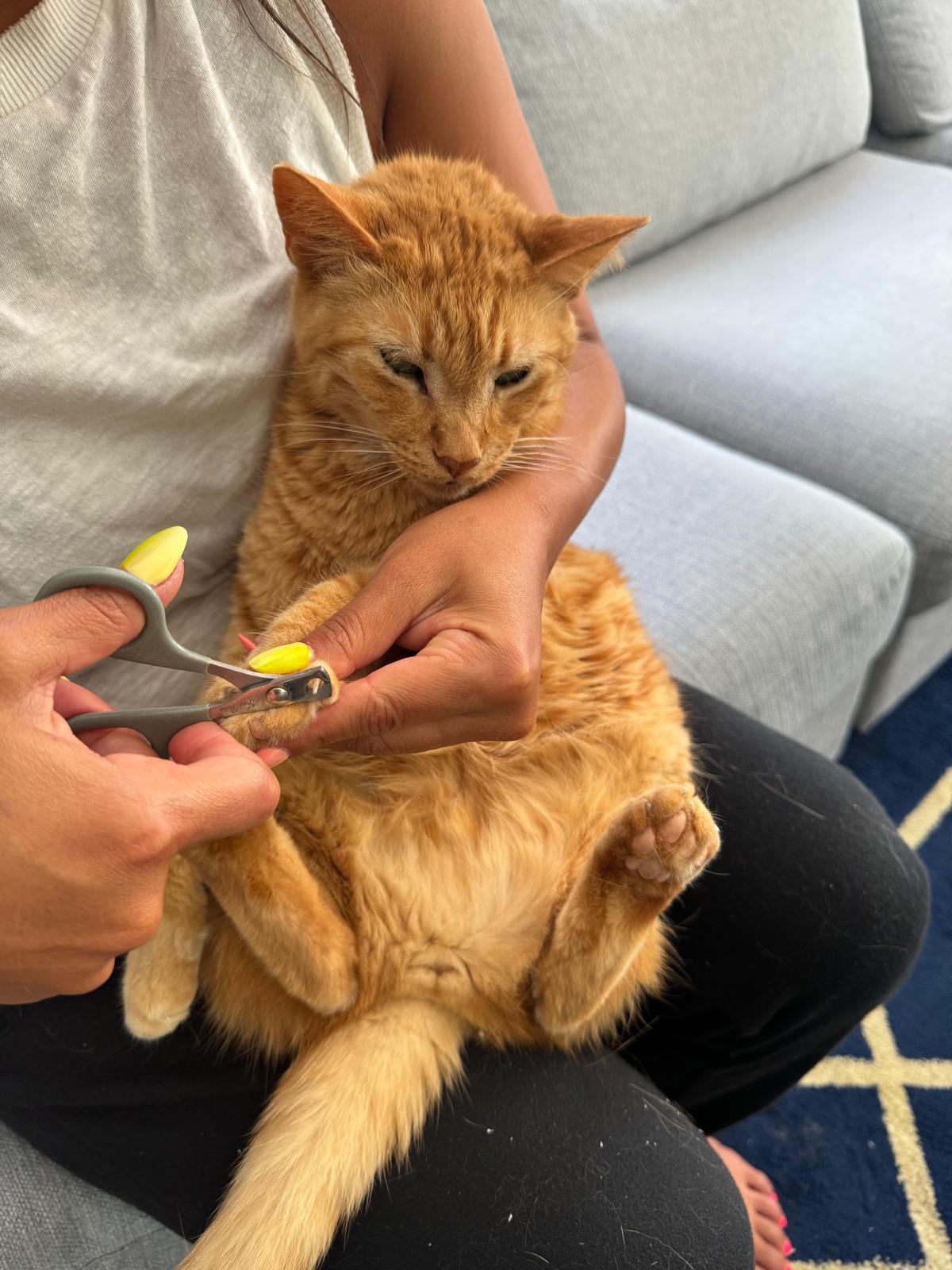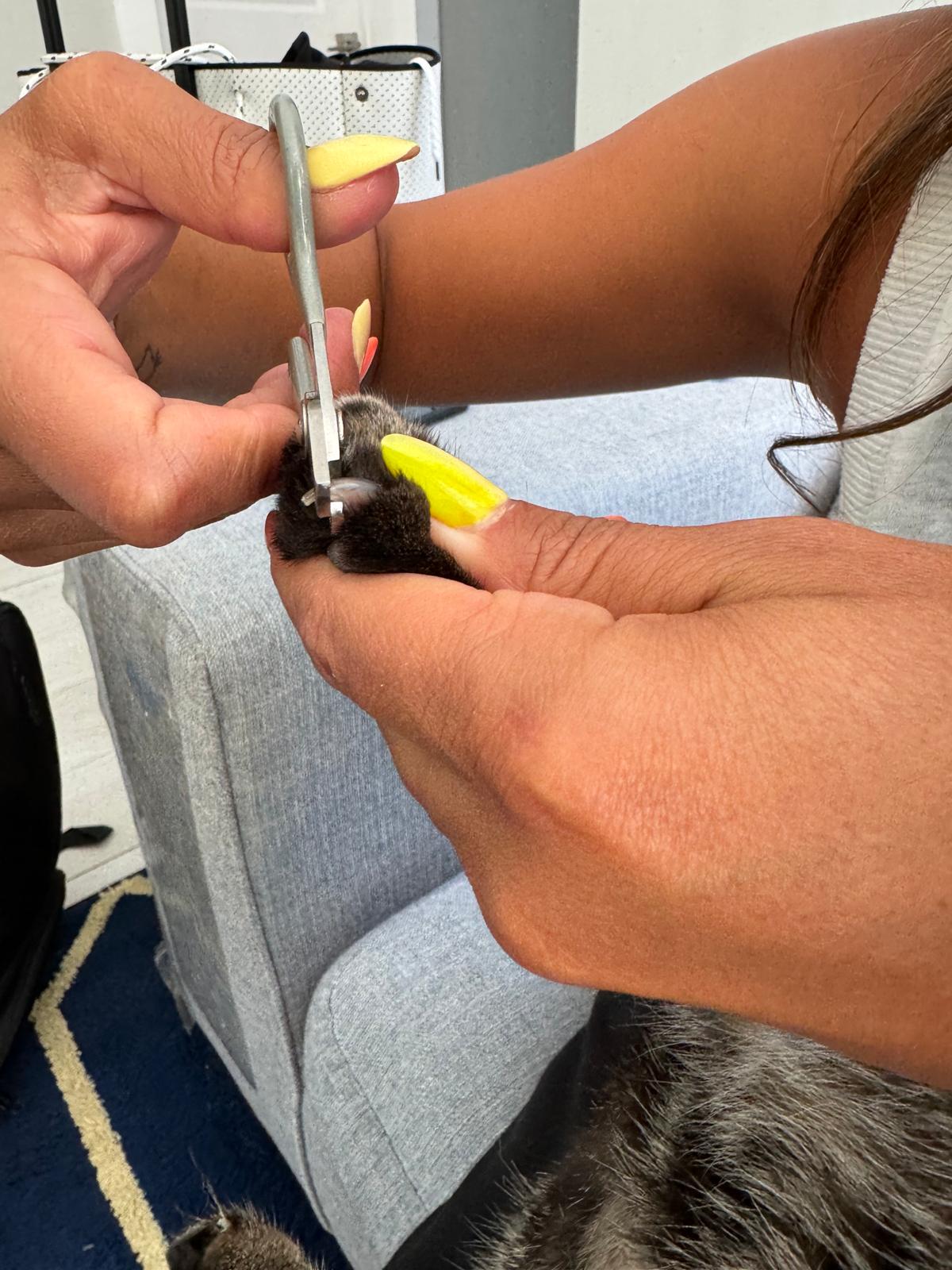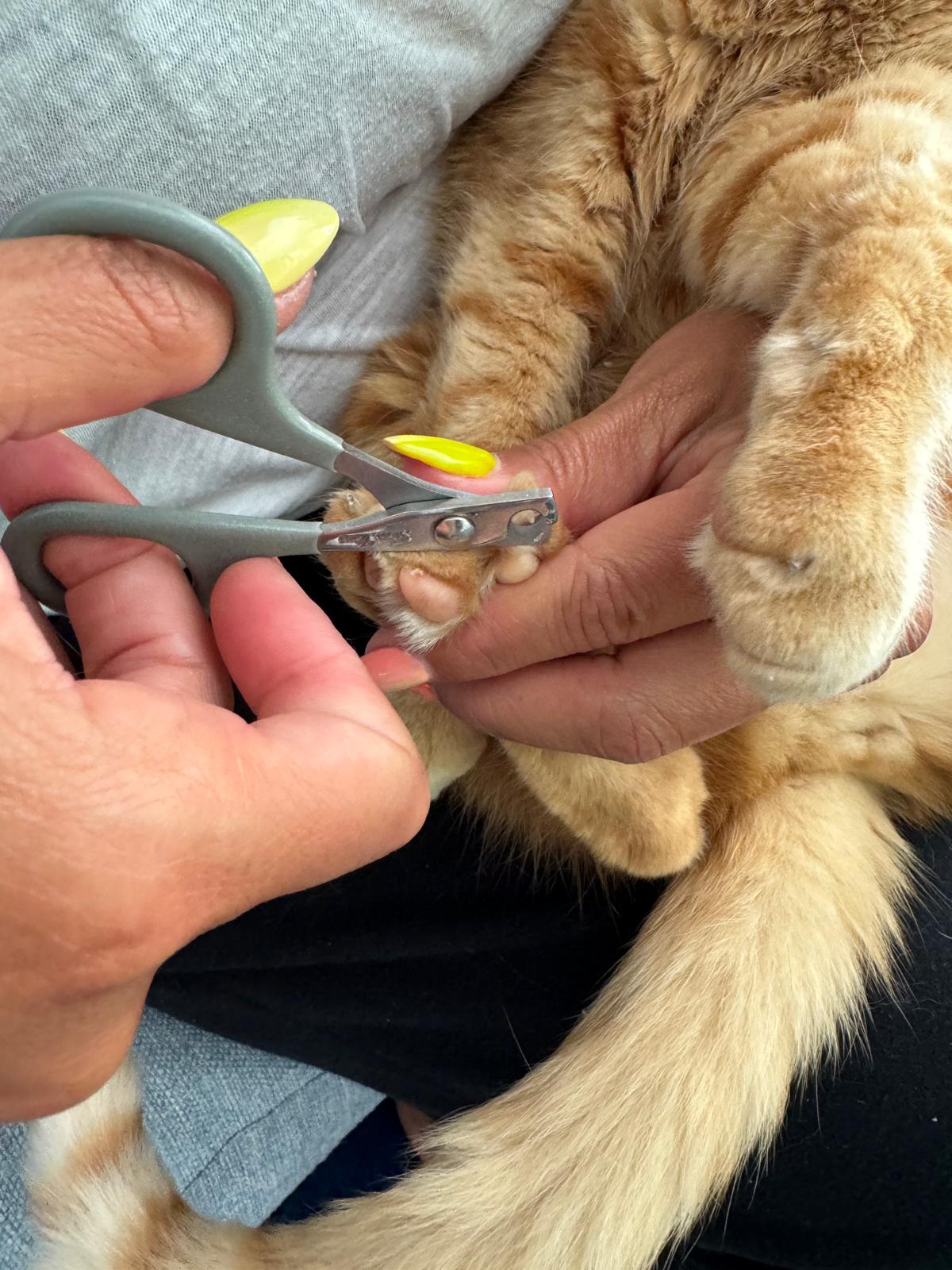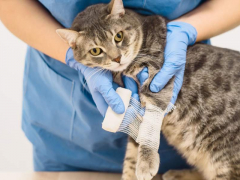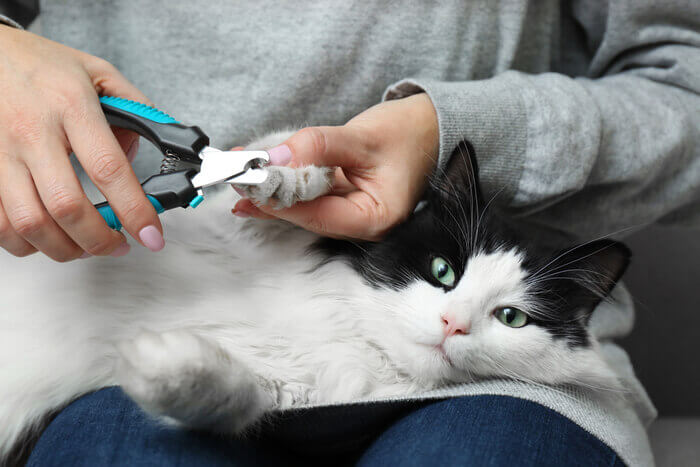
Keeping your cat’s nails trimmed short is a necessary task, but one that is daunting for many cat owners. Like human fingernails, a cat’s nails grow continuously. Although some cats wear their claws down, other cats (especially indoor cats) don’t wear their toenails down much.
If you don’t trim the nails regularly, they can snag on things and tear, causing injuries that require veterinary attention. If not attended to, cat nails can even grow around in a circle and end up penetrating your cat’s paw pad—ouch!
Long, sharp nails also hurt more if your cat accidentally scratches your skin, and sharp nails can do far more damage if your cats scratches your couch or chair.
Also Read: How To Stop Cats From Scratching Furniture
If you’ve never trimmed your cat’s nails before, you might not know where to begin. Never fear!
With the right tools and some helpful tips, you can easily learn to trim your cat’s nails at home. If after reading this tutorial, you are still nervous, ask your veterinarian or groomer for help. Most pet professionals will provide a quick demonstration. They will also trim your cat’s nails for you for a fee.
Tools You Need To Trim Your Cat’s Nails
Before getting started, make sure you have the right nail trimming tools. You can purchase all the nail clipping tools you need at a pet-supply store or online at Amazon or another online retailer.
You will need:
- Small-sized pet nail clippers: You can find cat nail clippers or just smaller clipper that can be used for cats and small dogs. Clippers come in various styles, including scissors style (also called pliers style) or guillotine style. Which type of nail clipper to choose is very much personal preference. Both styles work well for cutting cat nails.
- Nail file or nail grinder: These tools are optional, but if your cat obliges, you might like to file the nails after clipping them so they are smooth. It’s possible to use a pet nail grinder in place of a nail clipper, but these tools have a learning curve. They also vibrate and make noise. Some cats may find nail grinder scary.
- Styptic pencil or styptic powder: An anticoagulant product comes in handy if you accidentally nick the quick, which is the pink vein running through the inside of the nail. If you don’t have these, you can use cornflour or cornstarch as substitutes.
- Tasty treats: Whether tuna, chicken or your cat’s favorite treat, using goodies will help convince your cat to remain still and that nail trimming can be an enjoyable experience.
Slowly Introduce Your Cat to Nail Trimming
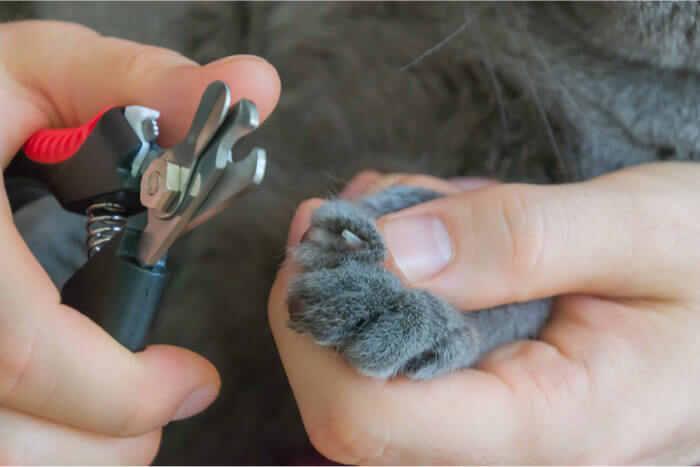
Cats have small nails, so choose small nail clippers in whatever style appeals to you
If you have a kitten, or if you are trimming your older cat’s nails yourself for the first time, start out simply by handling the paws to get your cat used to the sensation. Hold your cat gently (trying to pin them down will only make them nervous).
Squeeze your cat’s paws gently to extend the claws, but don’t try cutting them yet. Give your cat plenty of treats and petting, and end the session when she’s still happy and relaxed. Do this a few times a day for up to a week. If your cat is OK with this step, proceed to the next stage. If they struggle or seems uncomfortable, practice touching the paws and claws more before attempting to clip the nails.
Watch this great video from International Cat Care for more tips.
How To Hold A Cat To Trim Nails

Get your cat used to having her paws and nails handled before attempting to trim. Melina Grin / Cats.com
Next, move on to the actual nail trim. It’s easier if you have a helper who can hold the cat while you focus on trimming the claws, but you can also try holding your cat in your lap while you are sitting down, or you can place you cat on a table (lay down a soft towel first so they feel comfortable).
Place your nail clipping supplies nearby before getting your cat. Always start a nail trimming session with a few treats, and keep them handy in case your cat becomes upset.
Be sure to trim both the front claws and the back claws. Cats usually have four claws on each paw. Some cats also have dewclaws or and some have extra toes (called polydactyl cats).
Isolate one of your cat’s nails and look closely to see the quick (vein) running down the middle. It’s easy to see the quick inside a cat’s nail—it’s the pink part. Never cut into the quick, which filled with blood vessels and nerve endings. Cutting the quick is painful and quicked nails bleed (this is where styptic powder come in handy).
Holding the best cat nail clippers in your hand, make a smooth cut, trimming just the hooked white part of the nail that lies in below the pink part. Don’t try to clip the nails too short. It’s not necessary to cut right up to the quick. If you feel you didn’t trim off enough with the first cut, you can always trim a little more. If using a file, buff down the end of the nail to smooth it down.
Here Is A Step-by-step Breakdown Of Trimming A Cat’s Nails
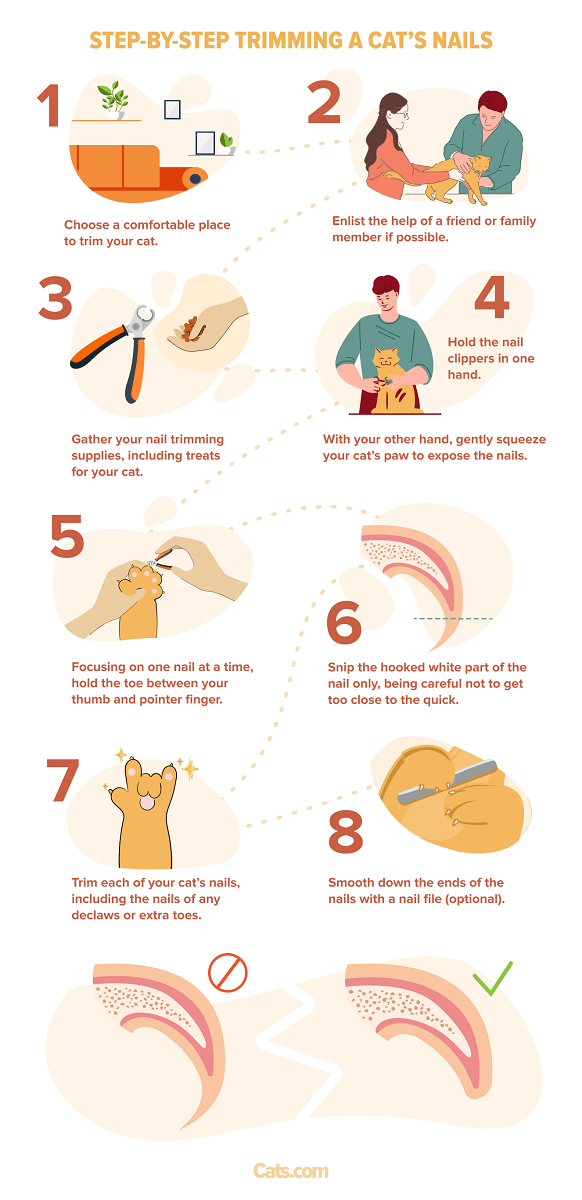
Cooperative nail trimming involves training a cat to tolerate nail clipping in the comfort of their home. You can teach the below training methods with a clicker or just food or treats.
Method 1: For a cat that is not clicker-trained
- Start the session by placing the nail clippers close by so the cat can see them. Treat your cat if he enjoys delicacies or if you wish to keep it relaxed.
- Introduce the nail clippers to your cat by letting them sniff it, which creates a positive association with the clippers.
- While your cat is lying relaxed on your bed or your lap, break the training down into the tiniest of steps:
- If your cat likes or tolerates handling, touch their shoulder first, followed by their leg.
- Move down the leg from there and reach out towards one paw.
- Gently touch one paw for one second.
- Gradually increase the length of time you touch the paw to three seconds.
- Lift the paw for one second.
- Increase the time you lift each paw while holding it lightly to three seconds.
- Raise the paw and press on one toe.
- Increase the pressure on the toe gradually until the cat lets you extend their claw.
- Once the claw is extended, reach toward the toe with the nail clipper, but don’t trim it yet.
- Touch the extended claw gently with the clippers.
- Trim one nail a tiny bit only (avoid the quick). Treat your cat once more.
- Initially, if successful, end the session with lots of praise and treats.
- Next day, continue the same steps until you trim all the nails on one paw.
- In a few days, continue trimming the nails on the second paw.
- Once your cat accepts having their paws clipped, trim the nails of the right foot.
- A few days later, finish trimming the nails of the left foot.
Method 2: If your cat is clicker trained and knows how to perform the cue ‘Shake Hands’
- Start the session by placing the nail clippers close by so your cat can see them. Click and treat your cat.
- Let your cat sniff the nail clippers. Click and treat to create a positive association with them.
- Have the cat target the nail clippers – click and treat several times.
- Cue ‘shake’ the right front paw. Click and treat several times.
- Cue ‘shake’ the left front paw. Clicker and treat several times.
- If your cat only uses one paw, teach them to shake hands with both paws.
- Next, follow these gradual steps, which can be adjusted to suit your cat (you can either add more or remove steps based on the cat’s behavior and mood):
- Hold the right paw elevated slightly longer (up to three seconds) before clicking and treating.
- Say the cue ‘toe’, then press one toe gently for one second. Click and treat.
- Repeat the above step for all the toes on the right front paw
- Repeat steps 8, 9 and 10 with the left front paw.
- Ask for a new ‘shake’, say ‘toe’ and press all the toes to extend the claws on both paws. Click and treat. Repeat several times for several days.
- Bring the nail clippers near the right front toe. Click and treat.
- Touch the nail clippers to the toenail. Click and treat.
- Clip one nail. Click and treat.
- If successful, end the session with lots of praise and treats.
- Next day, repeat all the above steps and trim the right front paw nails.
- A few days later, cue ‘shake’ and ‘toe’ and trim the left front paw nails.
- Continue until you trim all the nails on one toe, then the other side.
Also Read: Declawing Cats: What You Need To Know
What To Do If You Cut The Quick?
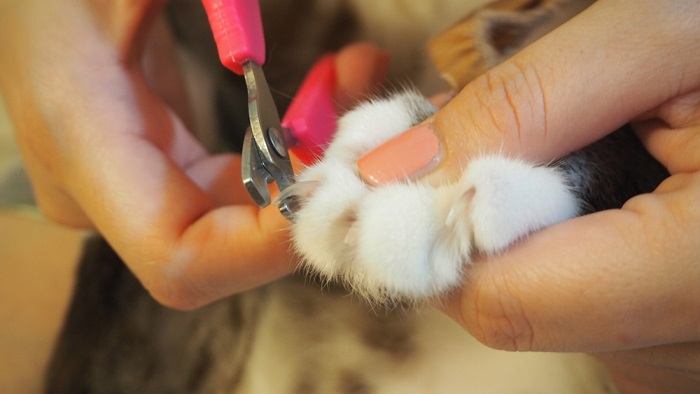
Because it’s so easy to see the quick in cat nails, cutting the quick is somewhat uncommon when trimming cat nails. It happens more frequently in dogs since many dogs have black nails and you cannot see the quick. You’re more likely to cut the quick if your cat is struggling or trying to move her paw while you’re trimming the nails.
If you do accidentally cut into your cat’s quick, do not panic. Cutting the quick hurts, and your cat might cry or pull away. If the cut was deep, the quick may bleed. But all that said, cutting the quick is a minor injury, and one that can be dealt with using your styptic powder.
Place a little bit of powder on your finger or a cotton swab and press it gently but firmly against the bleeding nail. Hold it there for a minute or two until the bleeding stops. Vow not to trim too close to the quick again, or your cat may begin to resist your nail trimming efforts.
How Often To Trim Your Cat’s Nails?
All cats wear their nails down differently depending on how much they use a scratching post, run or climb. Examine your cat’s nails at least every two weeks, and trim them when they grow too long. Every 2-4 weeks is ideal.
You’ll notice the rear nails are often much shorter than the claws in the front. Trim your cat’s nails about every two weeks. The nails on the front paws are often longer than the nails on the rear paws. Some cats wear down their rear nails more as they run and climb. If the rear nails are short, simply snip the tips.
Keeping your cat’s nails trimmed short is key in order to avoid injuries to the claws and paws. Nails may grow right into the paw pad, causing a potentially painful injury. Keeping the your cat nails trimmed may help to minimize scratches to your furniture.
Important Tips
- When using food or treats, present the food when you are doing the behaviour (e.g. touching the paw) and remove the food when you are not touching the paw.
- Be mindful since cats have sensitive nerve endings in their paw pads and may not like their toes touched unexpectedly.
- If your cat is wriggly or uncomfortable with the nail trim, break down the steps even further or repeat them multiple times before proceeding to the next step.
- You may never be able to trim all the nails in one go.
- Some cats may never accept cooperative nail trimming due to previous negative experiences.
- Establish a consistent routine of trimming one or two nails every few days so that all the nails are trimmed every 10-16 days.
